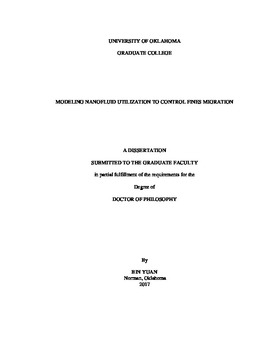| dc.contributor.advisor | Moghanloo, Rouzbeh | |
| dc.contributor.author | Yuan, Bin | |
| dc.date.accessioned | 2017-05-19T18:16:46Z | |
| dc.date.available | 2017-05-19T18:16:46Z | |
| dc.date.issued | 2017-05-12 | |
| dc.identifier.uri | https://hdl.handle.net/11244/50898 | |
| dc.description.abstract | This dissertation presents analytical solutions to address several unresolved issues on modeling of nanofluid utilization to control fines migration in porous media. Despite numerical simulations, analytical solutions derived in this dissertation yield explicit expressions in terms of controlling parameters.
The main objectives of this dissertation are as follows: 1) provide a profound insight into the mechanisms of fines migration in both single-phase (water) and two-phase (oil & water) flow; 2) evaluate the pros and cons of fines migration impact on improving performance of low-salinity waterflooding in terms of both well injectivity and oil recovery; 3) evaluate impacts of nanofluid on formation damage; 4) develop a theoretical structure to evaluate the success of nanoparticles to control fines migration in both linear and radial flow system. 5) compare the performance of two different schemes of nanoparticles utilization to control fines migration; 6) develop the mathematical foundations and investigate the feasibility of combining nanofluid with low-salinity water to improve production performance in layered reservoirs.
To accomplish the above objectives, the following tasks are pursued in this dissertation:
• Adsorption/detachment and straining behavior of nanoparticles and their effects on permeability are studied using analytical solutions. The analytical solutions are verified by experimental results.
• An application of method of characteristics (MOC) is examined to evaluate the effectiveness of nanoparticles to mitigate fines migration in single-phase flow for two different scenarios of nanoparticles utilization to control fines migration: (1) co-injection of nanoparticles with fines suspension into one-dimensional permeable medium and (2) pre-coating of porous medium with nanoparticles before injection. The analytical solutions are verified by both numerical simulations and experimental results.
• Nanofluid utilization to mitigate fines migration in two-phase (oil and water) flow is examined. The corresponding analytical solution is derived via implementing splitting method to transfer 3×3 system of governing equations into a combination of 2×2 auxiliary system containing only particles components (nanoparticles & fines) and one lifting equation with phase saturation. The analytical solutions are verified by numerical simulations.
• In two-phase flow, the integrated effects of fines migration and nanoparticles utilization are evaluated for two different schemes of nanoparticles utilization to control fines migration, including 1) co-injection of nanoparticle-fine particles mixture into 1-D permeable medium that initially oversaturated with fine particles and 2) pre-coating /pre-treatment with nanoparticles prior to fines injection in radial flow system.
• An axisymmetric radial flow model through single-layer homogenous/ multi-layer heterogeneous reservoirs systems is used to evaluate the mobility control obtained owing to fines migration. The same solution is used to optimize nanofluid treatment and to maintain well injectivity during low- salinity waterflooding. | en_US |
| dc.language | en_US | en_US |
| dc.subject | Engineering, Petroleum. | en_US |
| dc.title | Modeling Nanofluid Utilization to Control Fines Migration | en_US |
| dc.contributor.committeeMember | Harwell, Jeffrey | |
| dc.contributor.committeeMember | Rai, Chandra | |
| dc.contributor.committeeMember | Xingru, Wu | |
| dc.contributor.committeeMember | Shiau, Bor-Jier (Ben) | |
| dc.contributor.committeeMember | Bedrikovetski, Pavel | |
| dc.date.manuscript | 2017-04-28 | |
| dc.thesis.degree | Ph.D. | en_US |
| ou.group | Mewbourne College of Earth and Energy::Mewbourne School of Petroleum and Geological Engineering | en_US |
| shareok.orcid | 0000-0002-0450-3532 | en_US |
| shareok.nativefileaccess | restricted | en_US |
